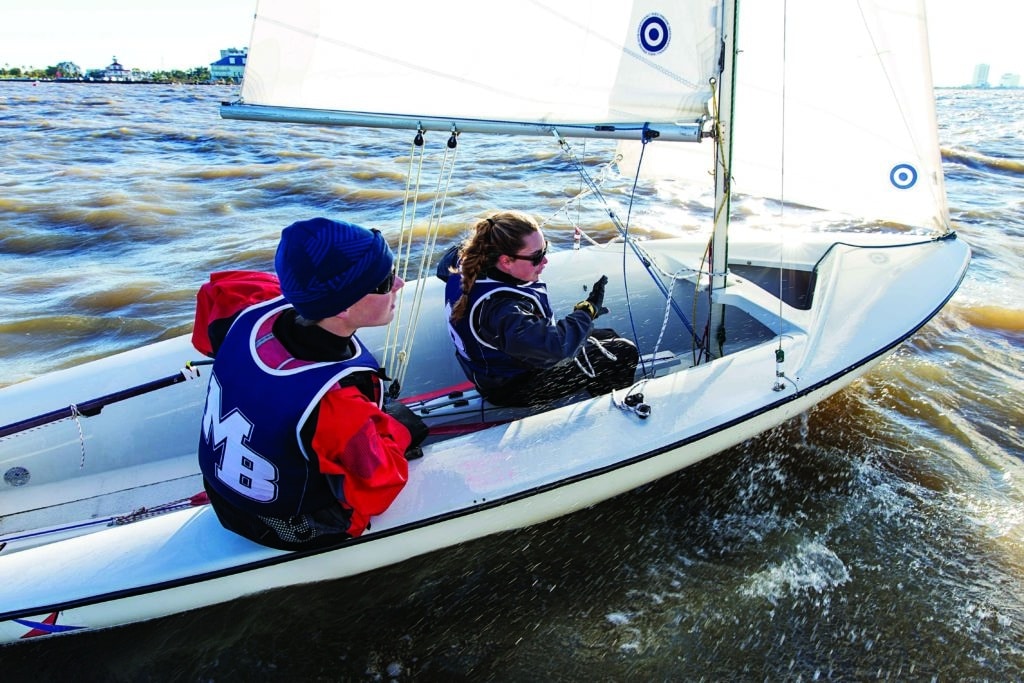
I step out of the rental car and stare at the stately three-story Southern YC. As a New Englander, I’m used to old, humble yacht clubs. I’ve never seen anything like Southern. I’m anxious about the high school regatta that has brought me to New Orleans for the first time, but once I walk into the place, I’m instantly at ease. I can tell it’s all about sailing.
This is going to be fun.
In 2005, when Hurricane Katrina wrecked New Orleans, Southern’s clubhouse burned to the ground, but even without a clubhouse, the members held regattas, including the Great Oaks Invitational, which started 17 years ago. The purpose of the regatta is to give developing high school teams the experience of a national championship. For the majority of American high school sailors, including me and my teammates from Moses Brown HS, it’s uncommon to fly to a regatta, so the Allstate Sugar Bowl Great Oaks Regatta is a big deal. Lake Pontchartrain is a tough place to sail, even for those familiar with lake sailing.
The first day is practice, a chance to get out and get a feel for the boats and conditions, which for us are extremely different. I’ve sailed on Rhode Island’s Narragansett Bay for almost 10 years, and the farthest I’ve ever traveled for a regatta is 45 minutes. What I experience on Lake Pontchartrain is completely different. The average depth is 10 feet, and the water is brown and brackish rather than deep, salty and blue. Shallow water causes much more chop and more random waves than we’re used to, and there isn’t any current, either. The winds come from random directions with random velocity, which isn’t a bad thing; it just takes skill. When you finally get it right, you look really smart.
Most high school sailing happens in the spring; it’s a combination of team racing, three versus three in 420s or FJs without spinnakers and trapezes. Summertime sailing is usually big-fleet racing with spinnakers and trapezes. The Great Oaks, however, is collegiate-style fleet racing, without spinnakers or trapezes and with much smaller fleets and smaller courses. Not a lot of high school sailors have experience with this type of racing, which requires faster tactics and strategy. At the Great Oaks, there are plenty of times when my crew and I are unsure of ourselves and what we’re doing.
After the first day of racing, two friends, my crew, my coach and I stroll Bourbon Street after enjoying a ridiculous amount of beignets. Here, in the heart of New Orleans, the sailing vibe of Southern YC fades, and we’re awestruck by the lights, the signs, and the endless sidewalks lined with bars and stores.
When a beaded necklace pelts me in the head, I look up and see a bunch of rowdy partiers tossing them everywhere. I can’t help but chuckle. There’s the smell of beer and urine in the gutters, but it’s refreshing to get beyond the regatta bubble and experience where we really are, to talk about things other than sailing. It clears my mind and takes it off the stresses of the regatta. Oddly enough, this one stroll is the highlight of the trip.
I’ll never forget Southern. Even though the conditions take a lot of teams by surprise, it’s exciting and opens our minds to learning new strategies. To become better, we need to sail in places we’re unfamiliar with. In only three days, the Great Oaks gave me a new outlook on sailing. This regatta is the pinnacle of parity in high school sailing. You don’t need to sail on the best team to sail in this regatta, and no matter where you’re from or how you sail, the love for such a unique sport is all the same.









